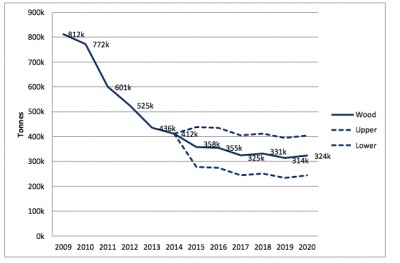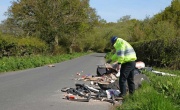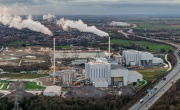Revised packaging figures mean drop in UK’s recycling performance
Recycling levels of wood, paper and card packaging are lower than previously thought says the Waste & Resources Action Programme (WRAP), after it increased its estimates of the amount placed on the market.
WRAP’s estimate for the amount of paper and card packaging placed on the UK market in 2014 has been raised to 4.75 million tonnes, 862,000 tonnes more than previously assumed. The figure for wood packaging has also increased significantly to 1.31 million tonnes (up 276,000).
The WRAP reports also provide estimates for the amount recycled in 2014, and with a higher amount placed on the market providing a larger supply the recycling rate has subsequently fallen.
The paper and card packaging recycling rate for 2014 was originally thought to be 90 per cent, but with the revisions that would now fall to 73 per cent.
Similarly the wood packaging recycling rate would decrease from 40 per cent to 31 per cent if the new estimates are taken into account.
Still hitting EU targets
The WRAP material flow reports are produced in partnership with consultancy Valpak and provide the Department for Environment, Food & Rural Affairs (Defra) with estimates that guide the department’s policy development and are used to report to the European Union’s requirements for recycling performance.

WRAP projections suggest that by 2020 the overall paper and card packaging recycling rate in the UK will rise as high as 85 per cent. Meanwhile the wood rate is expected to decline to 24 per cent in the next four years, though because of the presence of established high value end markets for wood packaging (for example wood recyclers that have good quality wood can send their material to end markets which could pay up to £200 per tonne rather than biomass, which attracts a much lower price per tonne) the recycling rate is falling much slower compared to the previous six years.
A third of the UK’s waste plastic recycled or reused
WRAP’s Plastics Spatial Flow report, also published this week, found that, in 2013, around 3.3 million tonnes of waste plastic arose in the UK, of which approximately one-third was collected for re-use, recycling or recovery with the other two-thirds becoming residual waste.

The report predicts that overall household waste plastic arisings may grow up to 2030 as household numbers and the consumption of plastic increases. It also predicts growth in the generation of waste plastics from the commercial sector as demand for construction, agriculture, electrical, automotive and other products rises.
The report is designed to show where in the UK packaging and non-packaging plastic is arising, helping potential investors and local authorities to ‘better understand where opportunities are’. The research, again carried out by WRAP and Valpak this time for the Department for Business, Energy and Industrial Strategy, assesses the source, polymer and current end markets and treatments that plastic undergoes.
A WRAP statement on the plastics report said: ‘A steady consistent supply of quality recovered plastics helps assure the long term commercial success of plastics recycling facilities and this report identifies the location and quantities of plastics available.
‘This could help potential investors in the UK plastics recycling industry who are trying to understand the best place to position a new plant in order to receive maximum desired feedstock with the lowest transport costs. It could also help local authorities to better understand the current availability of plastic in their local region, which could potentially be used as a feedstock for recycling (either traditional mechanical recycling or for more advanced polymer cracking).’
The full Wood Flow 2020, Paper and Card Flow 2020 and Plastics Spatial Flow reports can be downloaded from the WRAP website. 






